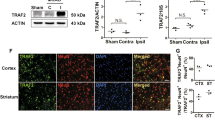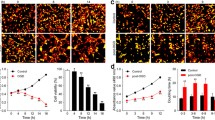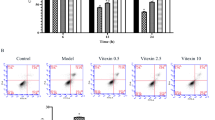Abstract
In recent years, more attention has been given to novel patterns of cell death observed during ischemia/reperfusion (I/R). Necroptosis is a regulable secondary cell death pathway; necroptosis is different from traditional forms of cell death, and it is regulated by the RIPK1-RIPK3-MLKL signaling pathway. JLX001 is the double hydrochloride of the natural compound cyclovirobuxine D (CVB-D). Previous studies have confirmed that CVB-D exerts a significant effect on cardiovascular and cerebrovascular diseases and that JLX001 can reduce ischemic brain injury by inhibiting cell apoptosis. For the first time, this project explored the in vivo and in vitro inhibitory effects of the therapeutic administration of JLX001 on the neuronal necroptosis caused by cerebral ischemia–reperfusion injury (CIRI). The middle cerebral artery occlusion reperfusion (MCAO/R) model was used to simulate I/R injury in rats in vivo, and oxygen-glucose deprivation and reperfusion (OGD/R) was used to simulate I/R injury in vitro. After the administration of JLX001, the relative expression of necroptosis-related molecules was measured by ELISA, RT–PCR, HE staining, immunofluorescence and Western blotting. The results showed that JLX001 significantly reduced pathological damage and the cerebral infarction rate in rat brain tissues, and the expression of neuronal necroptosis-related molecules was reduced, suggesting that JLX001 may regulate CIRI through the classic RIPK1-RIPK3-MLKL necroptosis pathway.










Similar content being viewed by others
References
Ao L-Y, Li W-T, Zhou L et al (2019) Therapeutic effects of JLX-001 on ischemic stroke by inducing autophagy via AMPK-ULK1 signaling pathway in rats. Brain Res Bull 153:162–170
Brewer GJ, Torricelli JR, Evege EK et al (1993) Optimized survival of hippocampal neurons in B27-supplemented Neurobasal, a new serum-free medium combination. J Neurosci Res 35(5):567–576
Chen Y, Zhang L, Yu H et al (2018) Necrostatin-1 improves long-term functional recovery through protecting oligodendrocyte precursor cells after transient focal cerebral ischemia in mice. Neuroscience 371:229–241
Dannappel M, Vlantis K, Kumari S et al (2014) RIPK1 maintains epithelial homeostasis by inhibiting apoptosis and necroptosis. Nature 513(7516):90–94
Deng X-X, Li S-S, Sun F-Y (2019) Necrostatin-1 prevents necroptosis in brains after ischemic stroke via inhibition of RIPK1-mediated RIPK3/MLKL signaling. Aging Dis 10(4):807–817
Deroo E, Zhou T, Liu B (2020) The role of RIPK1 and RIPK3 in cardiovascular disease. Int J Mol Sci 21(21):8174
Duprez L, Takahashi N, Van Hauwermeiren F et al (2011) RIP kinase-dependent necrosis drives lethal systemic inflammatory response syndrome. Immunity 35(6):908–918
Frank D, Vince JE (2019) Pyroptosis versus necroptosis: similarities, differences, and crosstalk. Cell Death and Differ 26(1):99–114
Hermann DM, Popa-Wagner A, Kleinschnitz C et al (2019) Animal models of ischemic stroke and their impact on drug discovery[J]. Expert Opin Drug Discov 14(3):315–326
Lesuisse C, Martin LJ (2002) Long-term culture of mouse cortical neurons as a model for neuronal development, aging, and death. J Neurobiol 51(1):9–23
Li W, Liu J, Chen J-R et al (2018) Neuroprotective effects of DTIO, a novel analog of nec-1, in acute and chronic stages after ischemic stroke. Neuroscience 390:12–29
Li X, Cheng S, Hu H et al (2020) Progranulin protects against cerebral ischemia-reperfusion (I/R) injury by inhibiting necroptosis and oxidative stress. Biochem Biophys Res Commun 521(3):569–576
Liu T, Zhao D-X, Cui H et al (2016) Therapeutic hypothermia attenuates tissue damage and cytokine expression after traumatic brain injury by inhibiting necroptosis in the rat. Sci Rep 6:24547
Mandal P, Berger SB, Pillay S et al (2014) RIP3 induces apoptosis independent of pronecrotic kinase activity. Mol Cell 56(4):481–495
Naito MG, Xu D, Amin P et al (2020) Sequential activation of necroptosis and apoptosis cooperates to mediate vascular and neural pathology in stroke. Proc Natl Acad Sci USA 117(9):4959–4970
Newton K, Dugger DL, Wickliffe KE et al (2014) Activity of protein kinase RIPK3 determines whether cells die by necroptosis or apoptosis. Science (new York n.y.) 343(6177):1357–1360
Ovbiagele B, Nguyen-Huynh MN (2011) Stroke epidemiology: advancing our understanding of disease mechanism and therapy. Neurother J Am Soc Exp NeuroTher 8(3):319–329
Pasparakis M, Vandenabeele P (2015) Necroptosis and its role in inflammation. Nature 517(7534):311–320
Peisker T, Koznar B, Stetkarova I et al (2017) Acute stroke therapy: a review. Trends Cardiovasc Med 27:59–66
Qiu Y, Yin Q, Fei Y et al (2019) JLX001 modulated the inflammatory reaction and oxidative stress in pMCAO rats via inhibiting the TLR2/4-NF-κB signaling pathway. Neurochem Res 44(8):1924–1938
Rathkey JK, Zhao J, Liu Z et al (2018) Chemical disruption of the pyroptotic pore-forming protein gasdermin D inhibits inflammatory cell death and sepsis. Sci Immunol. https://doi.org/10.1126/sciimmunol.aat2738
Tang M-B, Li Y-S, Li S-H et al (2018) Anisomycin prevents OGD-induced necroptosis by regulating the E3 ligase CHIP. Sci Rep 8(1):6379
Vieira M, Fernandes J, Carreto L et al (2014) Ischemic insults induce necroptotic cell death in hippocampal neurons through the up-regulation of endogenous RIP3. Neurobiol Dis 68:26–36
Weinlich R, Oberst A, Beere HM et al (2017) Necroptosis in development, inflammation and disease. Nat Rev Mol Cell Biol 18(2):127–136
Xu Y, Wang J, Song X et al (2016) RIP3 induces ischemic neuronal DNA degradation and programmed necrosis in rat via AIF. Sci Rep 6:29362
Yan X, Yu A, Zheng H et al (2019) Calycosin-7––glucoside attenuates OGD/R-induced damage by preventing oxidative stress and neuronal apoptosis via the SIRT1/FOXO1/PGC-1 pathway in HT22 cells[J]. Neural Plast 2019:8798069
Yang M, Lv Y, Tian X et al (2017a) Neuroprotective effect of β-caryophyllene on cerebral ischemia-reperfusion injury via regulation of necroptotic neuronal death and inflammation: and. Front Neurosci 11:583
Yang X-S, Yi T-L, Zhang S et al (2017b) Hypoxia-inducible factor-1 alpha is involved in RIP-induced necroptosis caused by in vitro and in vivo ischemic brain injury. Sci Rep 7(1):5818
Yin Q, Zhao B, Zhu J et al (2020) JLX001 improves myocardial ischemia-reperfusion injury by activating Jak2-Stat3 pathway. Life Sci 257:118083
Yuan J, Amin P, Ofengeim D (2019) Necroptosis and RIPK1-mediated neuroinflammation in CNS diseases. Nat Rev Neurosci 20(1):19–33
Zhang S, Wang Y, Li D et al (2016) Necrostatin-1 attenuates inflammatory response and improves cognitive function in chronic ischemic stroke mice. Med (basel Switzerland) 3(3):16
Zhou L, Ao L-Y, Yan Y-Y et al (2019) JLX001 ameliorates ischemia/reperfusion injury by reducing neuronal apoptosis via down-regulating JNK signaling pathway. Neuroscience 418:189–204
Acknowledgements
This project was supported by the National Science and Technology Major Project of the Ministry of Science and Technology of China [2016ZX09101031] and [2019ZX09301-134], the China Pharmaceutical University “Double First-Class” Construction Technology Innovation Team Project [CPU2018GY23] and [CPU2018GY24] and the National Natural Science Foundation of China [82073845].
Author information
Authors and Affiliations
Contributions
WL and XG: were involved in collecting information and writing a draft of the manuscript. DX, LZ, FL and AY: consolidated information and were involved in modifying the article. YL and YH were involved in selecting the theme. All the authors read and approved the final manuscript. The authors declare that all the data were generated in-house and that no paper mill was used.
Corresponding authors
Ethics declarations
Conflict of interest
The authors declare no conflict of interest.
Additional information
Communicated by Sreedharan Sajikumar.
Publisher's Note
Springer Nature remains neutral with regard to jurisdictional claims in published maps and institutional affiliations.
Supplementary Information
Below is the link to the electronic supplementary material.
Rights and permissions
Springer Nature or its licensor holds exclusive rights to this article under a publishing agreement with the author(s) or other rightsholder(s); author self-archiving of the accepted manuscript version of this article is solely governed by the terms of such publishing agreement and applicable law.
About this article
Cite this article
Li, W., Gou, X., Xu, D. et al. Therapeutic effects of JLX001 on neuronal necroptosis after cerebral ischemia–reperfusion in rats. Exp Brain Res 240, 3167–3182 (2022). https://doi.org/10.1007/s00221-022-06474-9
Received:
Accepted:
Published:
Issue Date:
DOI: https://doi.org/10.1007/s00221-022-06474-9




